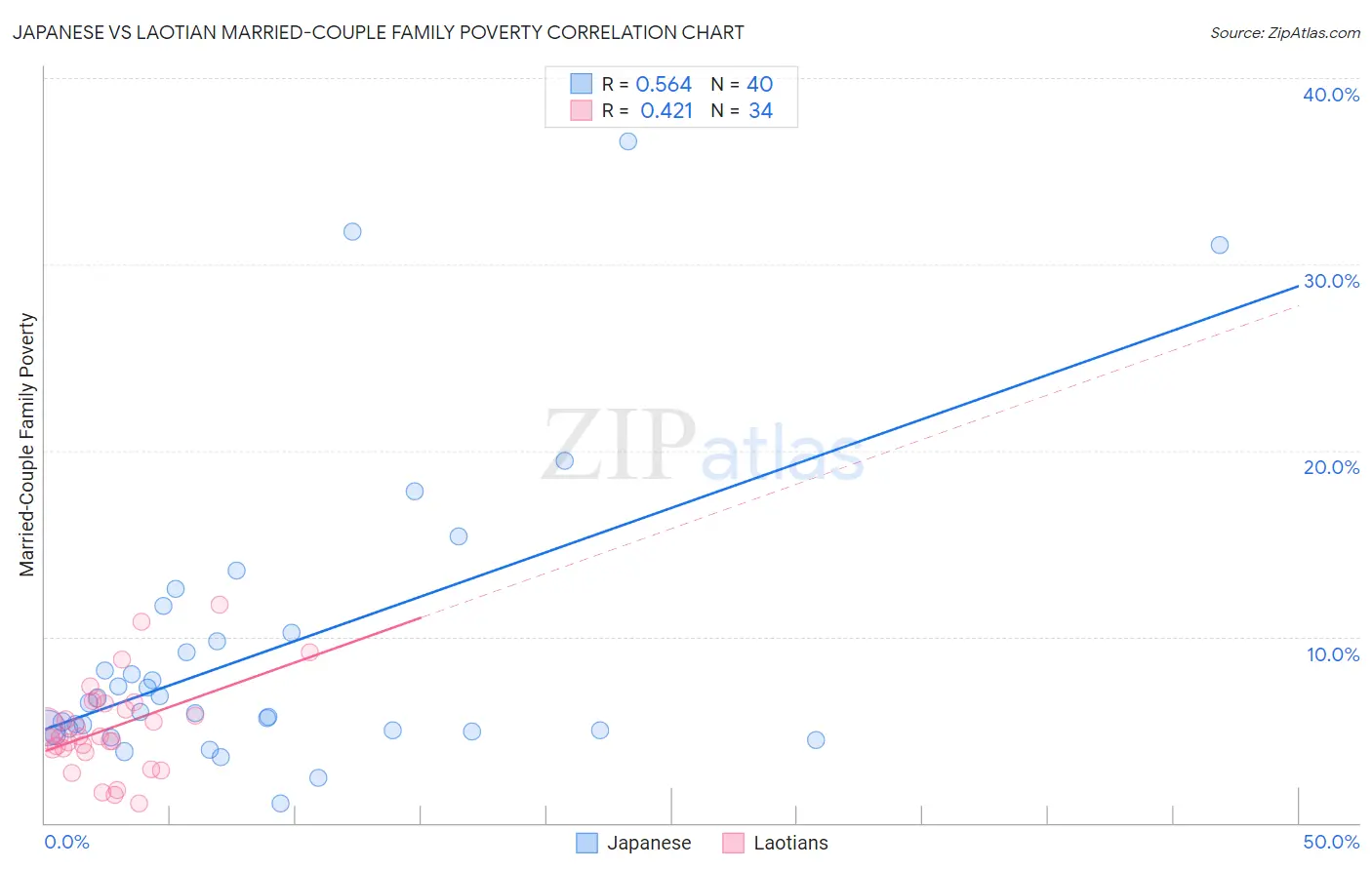Japanese vs Laotian Married-Couple Family Poverty
COMPARE
Japanese
Laotian
Married-Couple Family Poverty
Married-Couple Family Poverty Comparison
Japanese
Laotians
5.6%
MARRIED-COUPLE FAMILY POVERTY
9.8/ 100
METRIC RATING
219th/ 347
METRIC RANK
4.7%
MARRIED-COUPLE FAMILY POVERTY
96.6/ 100
METRIC RATING
108th/ 347
METRIC RANK
Japanese vs Laotian Married-Couple Family Poverty Correlation Chart
The statistical analysis conducted on geographies consisting of 247,969,020 people shows a substantial positive correlation between the proportion of Japanese and poverty level among married-couple families in the United States with a correlation coefficient (R) of 0.564 and weighted average of 5.6%. Similarly, the statistical analysis conducted on geographies consisting of 223,838,659 people shows a moderate positive correlation between the proportion of Laotians and poverty level among married-couple families in the United States with a correlation coefficient (R) of 0.421 and weighted average of 4.7%, a difference of 17.9%.

Married-Couple Family Poverty Correlation Summary
| Measurement | Japanese | Laotian |
| Minimum | 1.1% | 1.0% |
| Maximum | 36.6% | 11.7% |
| Range | 35.5% | 10.7% |
| Mean | 9.3% | 5.1% |
| Median | 6.2% | 4.6% |
| Interquartile 25% (IQ1) | 5.0% | 4.0% |
| Interquartile 75% (IQ3) | 10.0% | 6.4% |
| Interquartile Range (IQR) | 5.0% | 2.5% |
| Standard Deviation (Sample) | 8.0% | 2.5% |
| Standard Deviation (Population) | 7.9% | 2.4% |
Similar Demographics by Married-Couple Family Poverty
Demographics Similar to Japanese by Married-Couple Family Poverty
In terms of married-couple family poverty, the demographic groups most similar to Japanese are Colombian (5.6%, a difference of 0.19%), Panamanian (5.6%, a difference of 0.21%), Afghan (5.5%, a difference of 0.40%), Immigrants from Nigeria (5.5%, a difference of 0.42%), and Potawatomi (5.5%, a difference of 0.71%).
| Demographics | Rating | Rank | Married-Couple Family Poverty |
| Immigrants | Thailand | 14.0 /100 | #212 | Poor 5.5% |
| Immigrants | Liberia | 13.3 /100 | #213 | Poor 5.5% |
| Iroquois | 13.1 /100 | #214 | Poor 5.5% |
| Armenians | 12.8 /100 | #215 | Poor 5.5% |
| Potawatomi | 12.4 /100 | #216 | Poor 5.5% |
| Immigrants | Nigeria | 11.3 /100 | #217 | Poor 5.5% |
| Afghans | 11.2 /100 | #218 | Poor 5.5% |
| Japanese | 9.8 /100 | #219 | Tragic 5.6% |
| Colombians | 9.2 /100 | #220 | Tragic 5.6% |
| Panamanians | 9.2 /100 | #221 | Tragic 5.6% |
| Cajuns | 6.9 /100 | #222 | Tragic 5.6% |
| Immigrants | Fiji | 6.7 /100 | #223 | Tragic 5.6% |
| Sudanese | 6.4 /100 | #224 | Tragic 5.6% |
| Immigrants | Cambodia | 6.1 /100 | #225 | Tragic 5.6% |
| South Americans | 5.7 /100 | #226 | Tragic 5.6% |
Demographics Similar to Laotians by Married-Couple Family Poverty
In terms of married-couple family poverty, the demographic groups most similar to Laotians are Immigrants from Hong Kong (4.7%, a difference of 0.20%), Immigrants from Germany (4.7%, a difference of 0.26%), Immigrants from France (4.7%, a difference of 0.27%), Immigrants from Bolivia (4.7%, a difference of 0.36%), and Pakistani (4.7%, a difference of 0.40%).
| Demographics | Rating | Rank | Married-Couple Family Poverty |
| Yugoslavians | 97.8 /100 | #101 | Exceptional 4.6% |
| Asians | 97.6 /100 | #102 | Exceptional 4.7% |
| Immigrants | Romania | 97.3 /100 | #103 | Exceptional 4.7% |
| Immigrants | Moldova | 97.1 /100 | #104 | Exceptional 4.7% |
| Aleuts | 97.0 /100 | #105 | Exceptional 4.7% |
| Immigrants | France | 96.9 /100 | #106 | Exceptional 4.7% |
| Immigrants | Germany | 96.8 /100 | #107 | Exceptional 4.7% |
| Laotians | 96.6 /100 | #108 | Exceptional 4.7% |
| Immigrants | Hong Kong | 96.4 /100 | #109 | Exceptional 4.7% |
| Immigrants | Bolivia | 96.2 /100 | #110 | Exceptional 4.7% |
| Pakistanis | 96.2 /100 | #111 | Exceptional 4.7% |
| Tongans | 95.9 /100 | #112 | Exceptional 4.7% |
| Immigrants | Nepal | 95.9 /100 | #113 | Exceptional 4.7% |
| Immigrants | Indonesia | 95.1 /100 | #114 | Exceptional 4.8% |
| Taiwanese | 94.8 /100 | #115 | Exceptional 4.8% |